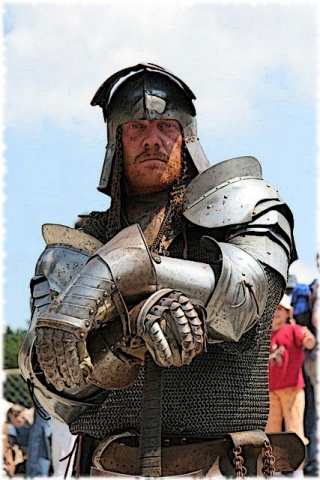William the Carpenter
Appearance: A huge hulking man in armor. He is dirty and careless in everyday life. His eyes are a light brown, his hair and beard are a dark auburn, tied back.
Behavior: Rude, course, and braggadocios, he is also very short tempered. A man of his size gets away with such things.
William's actions at the Siege of Antioch are known from the Gesta Francorum, an anonymous chronicle written by an Italo-Norman eyewitness. The Gesta was very popular in Europe after the crusade, but was considered crudely written by more refined readers. It was later rewritten and expanded by more educated writers, including the French monks Robert and Guibert, both of whom were eager to add information about French crusaders like William. According to Robert, William "acquired the name of 'Carpenter' because nobody wanted to take him on in battle—-there was no breastplate, helmet or shield which could withstand the shattering impact of his lance or sword." Guibert says that he "was called the Carpenter, not because he was a craftsman in wood, but because he prevailed in battle like a carpenter, by cutting men down", and has Bohemond ask: "what kind of Carpenter did we have, who, like a construction-worker with a pick-axe, hacked away, with lances and swords, at the backs of the Gentiles?" Christopher Tyerman interprets this as William's "skills as a battlefield butcher". Edward Gibbon, apparently misunderstanding Guibert, thought the nickname came "from the weighty strokes of his axe"
History: According to twelfth-century monk Guibert of Nogent, William was "powerful in words, but less so in action...a man who set out to do things too great for him." William was a member of the French contingent which marched into Spain in 1087 to assist Alfonso VI of Castile with the siege of Tudela against the Almoravids. He may have been one of the leaders, along with Eudes I, Duke of Burgundy, who was the nephew of Alfonso's wife Constance. The French army never made it to Tudela and withdrew with little success. Guibert says that William "retreated like a wretch, leaving countless men stranded by his flight." William's actions in Spain may have been the inspiration for the character of Ganelon in the Chanson de Roland, which was possibly written in the early twelfth-century, based on similar events that had occurred during the reign of Charlemagne centuries earlier.
In France, Guibert says he engaged in petty warfare against other nobles and "criminal looting" of the countryside, in contravention of the Peace and Truce of God. In 1096 he joined the First Crusade, and "took from his poor neighbors the little that they had to provide himself shamefully with provisions for the journey." He participated in the attacks on Jews at Mainz, led by Emicho of Flonheim. Emich's army later battled against the Hungarians, during which William "beheaded the chief of the Hungarian army, who was a member of the [King Coloman's] counsel, a distinguished man with dazzling snow-white hair." After the dispersal of Emicho's army following this battle, William and the other French leaders joined the army of his relative Hugh of Vermandois. Hugh's army marched south into Italy, and at Bari, Hugh sent William across the sea to Dyrrhachium as an ambassador to the Byzantine governor of the city. William then traveled to Constantinople with Hugh, and he was among the men who came to meet Godfrey of Bouillon when Godfrey arrived at the city later in the year.
Recent Events:
